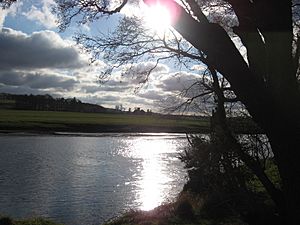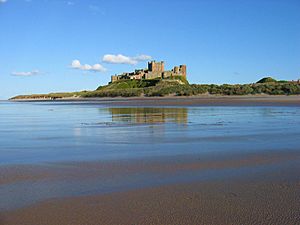Battle of Carham facts for kids
Quick facts for kids Battle of Carham |
|||||||
|---|---|---|---|---|---|---|---|
 St Cuthbert's Church, Carham, viewed from the other side of the Tweed, where the battle took place. The minster was a significant economic and administrative centre. |
|||||||
|
|||||||
| Belligerents | |||||||
| Northern English of Bamburgh / Earldom of Northumbria | Kingdom of Scotland Kingdom of Strathclyde |
||||||
| Commanders and leaders | |||||||
| Uhtred of Bamburgh | King Malcolm II Owen the Bald |
||||||
The Battle of Carham was a big fight between the English ruler of Bamburgh and the King of Scotland. The Scottish king had teamed up with the Cumbrians, who were people from the Kingdom of Strathclyde. This battle happened in the 1010s, most likely in the year 1018. It took place at a spot called Carham on Tweed, which is now in Northumberland, England.
The English side was led by Uhtred the Bold, a powerful leader from Bamburgh. He fought against the combined armies of Malcolm II of Scotland, the Scottish king, and Owen the Bald, who was the king of the Cumbrians (or Strathclyde). In the end, the Scots and Cumbrians won the battle.
Contents
How Do We Know About the Battle?
Historians don't have any records written exactly when the battle happened. For example, the Anglo-Saxon Chronicle, a very important record from that time, doesn't mention it.
We mainly know about the Battle of Carham from historical writings put together in Durham in the 1100s. One writer, a monk named Symeon of Durham, wrote around 1110 about a "famous battle" in 1018. He said that a huge number of Scots defeated the Northumbrians (the English from the north). He even wrote that the local bishop died from sadness after the battle.
Another old text, called Historia Regum, described it as a "massive battle between the English and the Scots" at Carham. These writings help us understand what happened, even though they were written some time after the event.
Why Did They Fight?

The main leaders in this battle were Uhtred, who led the English from Bamburgh, and King Malcolm II of Scotland, along with Owen the Bald, the king of the Cumbrians.
Uhtred belonged to a powerful family that had ruled the area around Bamburgh Castle for a long time. Their lands stretched from the Firth of Forth down to the River Tyne. Uhtred was a very important leader, even governing a larger area of northern England for a while.
However, things changed for Uhtred around 1016 when the Danish ruler Cnut the Great became king of England. Uhtred lost some of his power and was mainly in charge of his home region around Bamburgh. This made his territory a tempting target for his neighbors.
The Scots lived north of Bamburgh, across the Firth of Forth. To the west were the Cumbrians, who lived in the Kingdom of Strathclyde. The Cumbrians and Scots decided to team up against Uhtred. We don't know exactly why they joined forces, but Uhtred's weaker position probably made his lands an easy target to attack and take valuable things.
Years before, in 1006, the Scots had been defeated by the English from Bamburgh. So, this battle might have been a chance for the Scots to get revenge or gain more land. For King Malcolm II, winning battles and getting plunder (stolen goods) would have helped him stay popular and strong in his own kingdom. It's also possible they wanted to put their own chosen ruler in charge of Bamburgh or simply expand their territory.
What Was the Battle's Impact?
The Battle of Carham was a significant event, especially for the region of Lothian. For a long time, historians believed this battle led to the Scottish king taking control of Lothian, a large area that is now part of Scotland. Some earlier historians thought Lothian was given to the Scottish king even before this battle.
However, more recent historians are not so sure that the battle directly caused Scotland to take over Lothian. There isn't clear evidence from the time that links the battle to this land transfer. It seems that Scotland's full control over Lothian happened gradually, over many years, and wasn't complete until much later.
Still, the defeat at Carham was a big problem for the rulers of Bamburgh and the church in that area. It showed that they were facing a major crisis in the early 1000s. Because of these troubles, important religious items from the region were moved to Durham for safety.
Carham 1018 Society
There is a group called the Carham 1018 Society. Their goal is to learn more about the Battle of Carham, share information about it, and remember the event. Their website provides details about public meetings, events, and new discoveries related to the battle.

